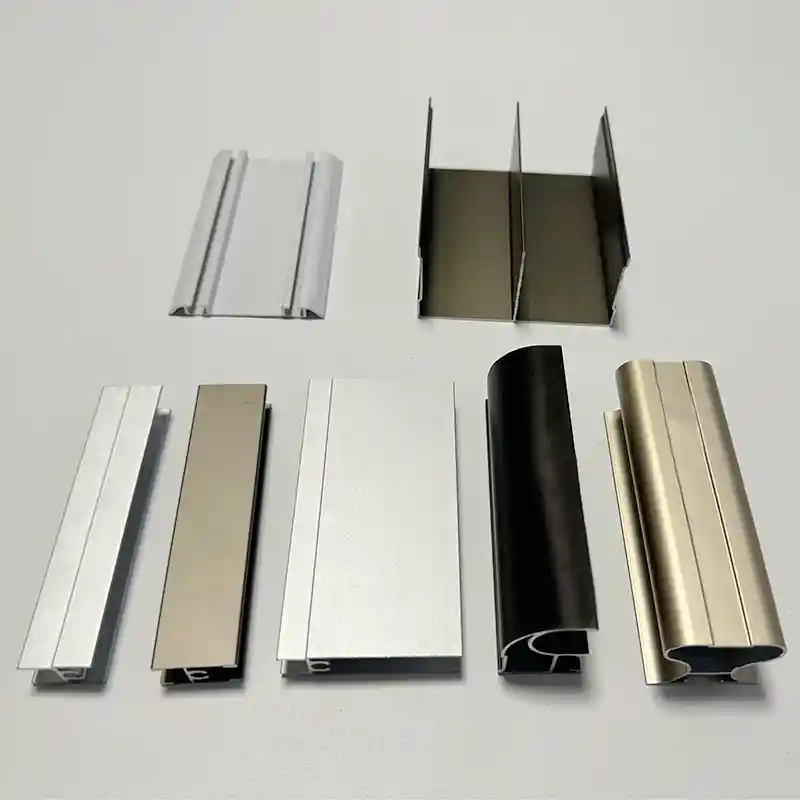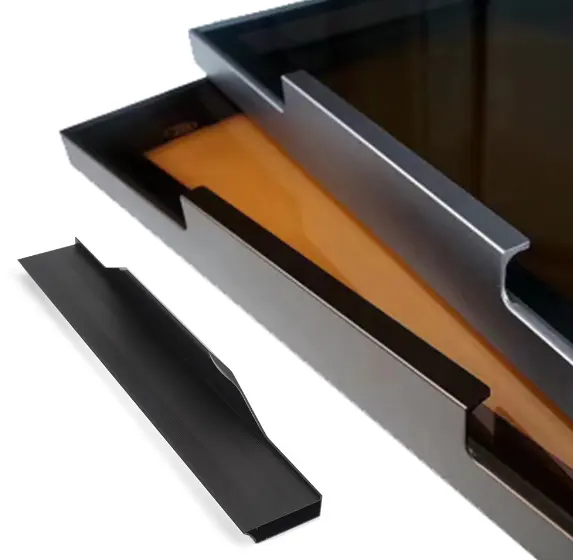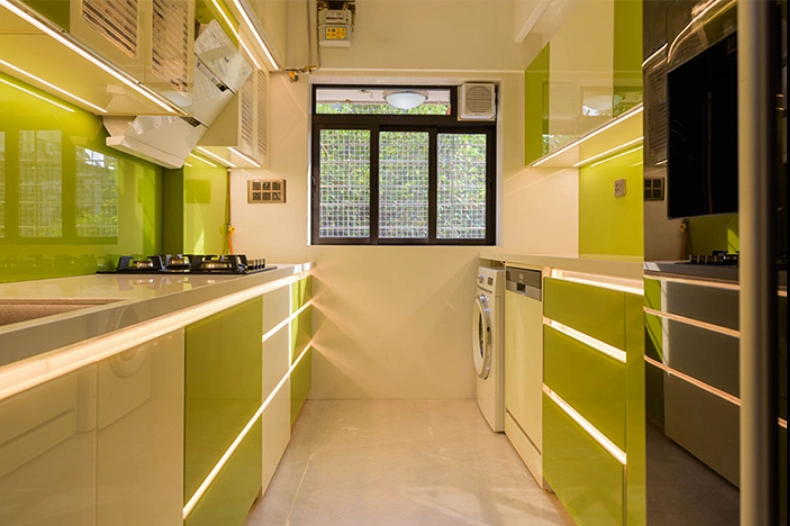Discover how aluminum profiles can revolutionize sliding wardrobe design with their lightweight durability, modern aesthetic, and low-maintenance appeal. Whether you’re seeking customization or cost-efficiency, these profiles offer the perfect blend of style and function for contemporary furniture solutions. Dive into the essential details to make informed choices for your wardrobe upgrade!
Understanding the Aluminum Profile
1. Definition and Use
The term “aluminum profile” describes any structural element built of aluminum of specific cross-section form. Their usage is broad: in building and construction, particularly in furniture, wardrobes, and many other contraptions making, as supportive structural pieces; to provide a structure that enables so many conceptions – from functional up to highly decorative.
2. Features of Aluminum
Aluminum is preferred in industries due to its inherent nature. It is quite durable and strong; thus, whatever structure is made from it is solid and can withstand many years. Secondly, aluminum is resistant to corrosion, which allows it to be set up in most conditions that have moisture or chemicals. Another major positive attribute of aluminum is its light mass, which makes handling and mounting easy.
3. Applications in Furniture Design
The application of aluminum profiles in furniture design has increased noticeably, especially for wardrobe doors. Their modern look and sleekness make them popular in contemporary interiors. Aluminum profiles are presented with several design variants to fit different interior styles. Their durability and resistance to wear and tear make them practical for everyday use, while their aesthetic versatility allows them to complement various design themes.
Types of Aluminum Profiles
1. Standard Profiles
The different standard shapes of aluminum profiles are used for specific purposes. Some of the common types are:
-C-shaped profiles are one of the most usable types in making wardrobe frames and shelves. It gives good structural support and is easy to assemble.
-U-shaped profiles have more strength, so they can be used as end panels or for unique shapes in custom-made designs.
-The T-shaped profiles are designed for sliding doors with grooves that house the sliding mechanism for smooth and frictionless operation.
-H-shaped profiles are used in heavy applications and provide high strength and rigidity, especially in structures that need to bear significant weight.
2. Customized Profiles
While standard profiles suit many purposes, certain wardrobe systems demand custom profiles for ultimate compatibility. These profiles are made in a manner to match the dimensions and guide channels of specific systems and are fitted for perfect compatibility with great ease for the best results.
Selecting the Correct Type of Aluminum Profile for Your Wardrobe
The following are the most critical aspects one should not neglect while selecting the aluminum profiles meant for the wardrobe:
1. Compatibility
Let the compatibility of the aluminum profiles be complete with the selected wardrobe system. It includes that the profiles should match the dimensions and guide channels of the system for proper fit and function.
2. Anodizing or Powder Coating
Both of these are surface treatments applied to increase the durability and aesthetic appeal of the aluminum profiles. Anodizing forms a protective oxide layer on the surface, improving corrosion resistance, while powder coating offers more color and texture options.
3. Corrosion and Wear Resistance
Profiles must be of the best-class aluminum alloys resistant to corrosion, especially in cases where your wardrobe will be exposed to moisture or chemicals. The type of alloy significantly affects its durability and resistance to environmental factors.
4. Thickness and Strength
The thickness and strength of the profiles are very important. Thicker profiles will provide better structural support and durability, especially for larger doors or when heavy items are stored in the wardrobe.
5. Design and Aesthetics
The profiles should match the overall design of the wardrobe. The shape, size, and finish of the profiles should be according to your taste, adding an extra touch to the wardrobe.
6. Profile size and dimensions
This is the selection of appropriate profile dimensions that will fit the structure of the wardrobe. The size of the profile will relate to the scale of your wardrobe design.
7. Weight
The weight the profiles can carry will depend on the weight of the doors, shelves, and other components that will be added. It is necessary to choose profiles with enough strength and thickness for this purpose to prevent it from bending or deforming under load.
8. Color Variants
Aluminum profiles are available in a wide array of colors, thus allowing flexibility to accommodate various interior designs. As such, they are easily fitted with the general decoration.
9. Installing Aluminum Profiles
Preparatory Steps Among the very first steps is to plan the wardrobe design, including its layout, size, and features it should have. Then, prepare everything you need to start the process: tools such as saws, screwdrivers, and measuring tape, and materials including the fasteners.
10. Measuring and cutting
Take accurate measurements from your design for the necessary dimensions of aluminum profiles. Profiles should then be cut to length using appropriate tools.
11. Basic Tools Equipment Needed
Most basic installations of aluminum profiles require only ordinary tools like saws and screwdrivers. Where the nature of the installation demands more complex methods, additional tools may be used.
12. Frame Assembly
The main frame of the wardrobe is assembled by aligning and fitting all the parts together accordingly.
13. Fixing Sliding Mechanism
Sliding mechanisms of the door are fixed with the help of T-shaped or compatible profiles in such a way that the sliding operation of the doors would be smooth and effective.
Advantages of Using Aluminum Profiles in Sliding Wardrobe
1. Durability and Strength
Aluminum has been tagged robust; it resists impact, dents, and scratches. Hence, wardrobes made using aluminum profiles would be able to bear day-to-day usage, maintaining their structure for a decent number of years.
2. Low Maintenance and Durability
The stains, tarnishing, and corrosion do not affect anodized aluminum profiles; thus, they require very minimal maintenance. This is quite practical for long-term uses and reduces frequent cleaning or repairing.
3. Lightweight
While being strong, the profiles of aluminum are lightweight and hence easy to operate and install. This cuts down the overall weight of the wardrobe and simplifies the installation process as well.
4. Fire Resistance
Intrinsically fire-resistant; an added advantage for safety and security. The material nature contributes to making the home a more secure place.
Cost Considerations for Aluminum Profiles
1. Price Range Summary
The cost of aluminum profiles varies depending on the type of profile, finishing, and even the supplier. Apart from these the fluctuation in the quality of alloy used and in the complexity of the design of the profile affects the price range.
2. Cost-Effectiveness Compared to Other Materials
Aluminum profiles balance very well with cost, durability, and aesthetic appeal. Although a bit costlier than some types of materials, their durability and less maintenance for a long period make them more cost-effective.
XiHui Aluminum Co., Ltd.:Your Trusted Partner
Xihui Aluminum Co., Ltd. Has been a professional company specializing in the manufacture of aluminum extrusion profiles for 30 years. They are into the production of a vast array of aluminum profiles, which include but are not limited to door and window, kitchen cabinets, tile decoration, wall panels, curtains, and home decoration, including industrial and architectural profiles. They also provide the corresponding scene application display and customization services with a great reputation in the industry for its reliability and commitment to quality in its production.
FAQs
1. What type of aluminum alloy is best for wardrobe profiles?
6063 aluminum alloy is typically seen as the go-to choice for wardrobe profiles because of its lightweight properties and resistance to corrosion. For demanding uses that require added strength and durability alloys such as 6061 and 6081 are preferred.
2. What is the difference between anodized and powder-coated finishes for aluminum profiles?
Anodized coatings form a shield of oxide that boosts resistance to corrosion and provides color options for enhanced aesthetics. Powder coatings offer a sturdier layer that excels, in withstanding impact and chemical exposure while allowing for more diverse design possibilities.
3. Are aluminum profiles suitable for DIY installation?
Certainly! Snap-together profiles are especially convenient as they need basic tools for assembly and are simple to put together. However, in instances requiring a hold machinery fasteners and expert installation might be the better choice.







